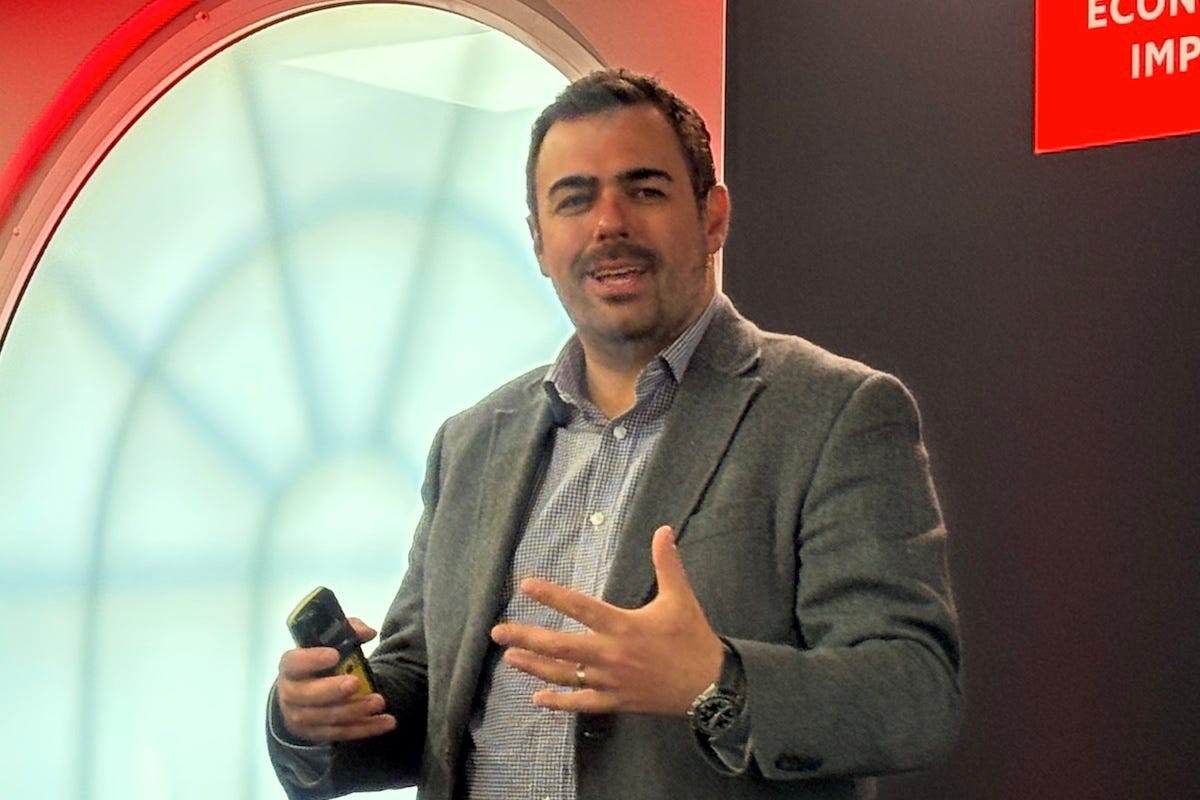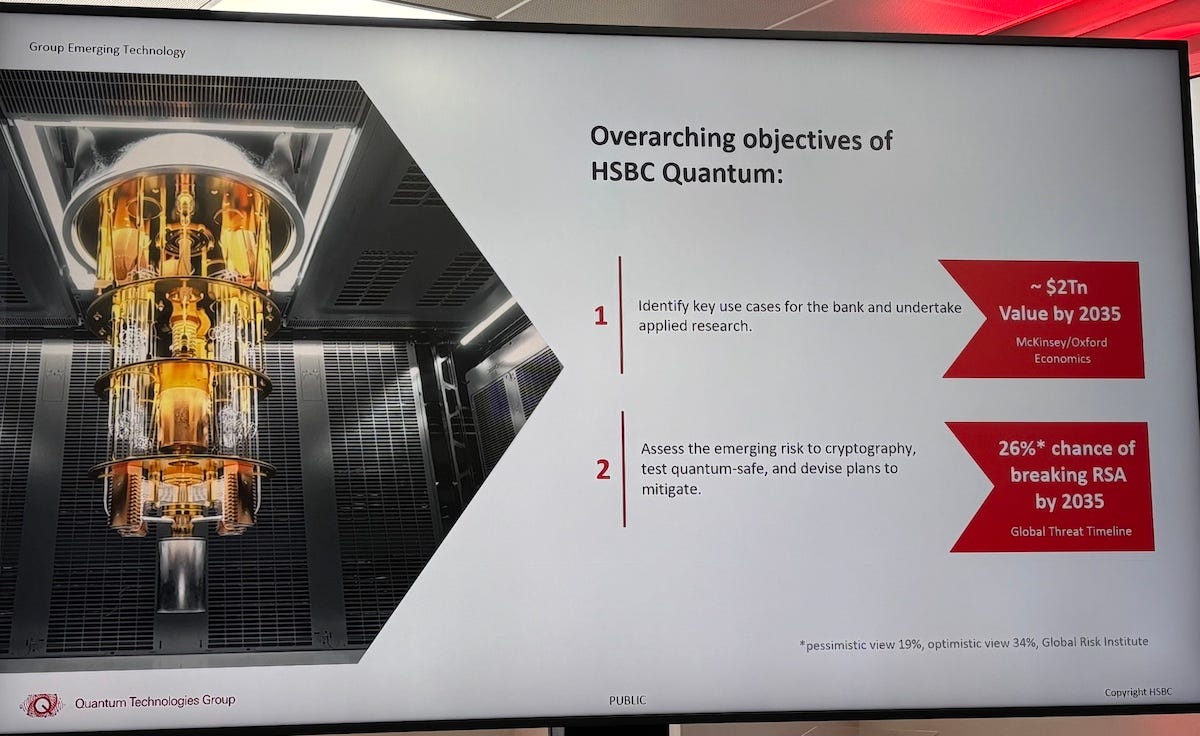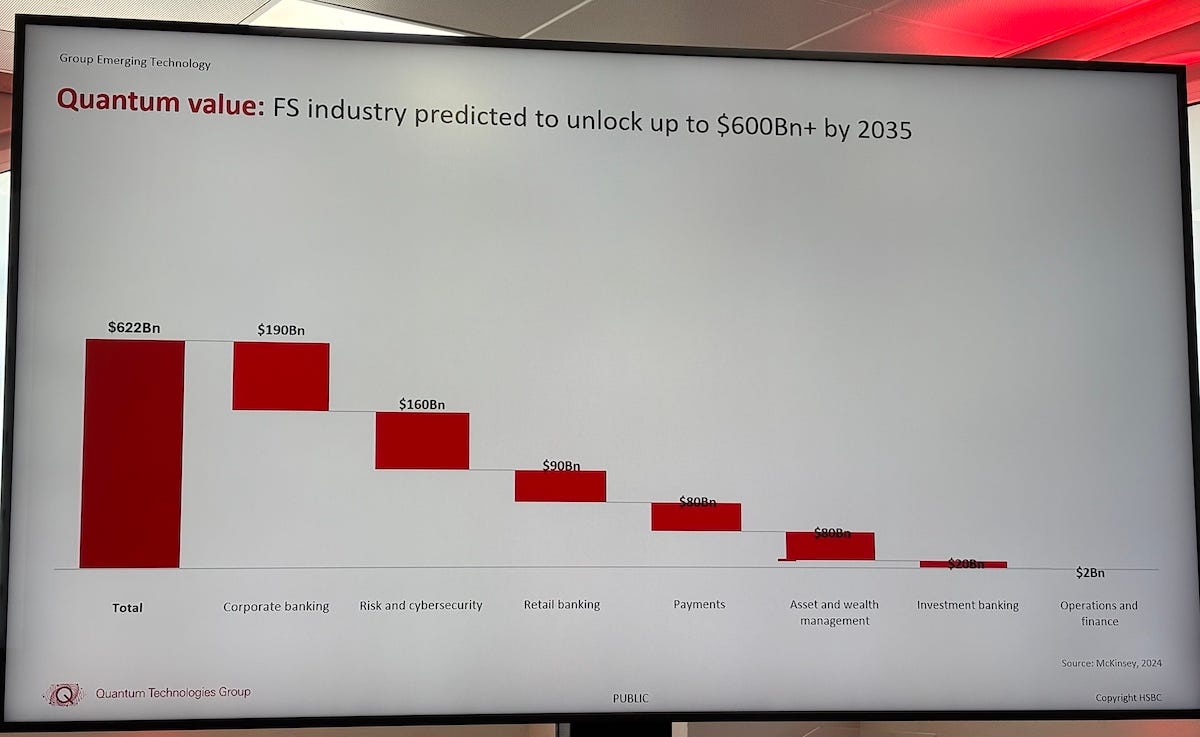HSBC Builds Quantum Capabilities to Tackle Cryptographic Threats and Unlock Business Value
The largest bank in Europe shares how it bridges theory and enterprise needs to create practical commercial applications from quantum technologies
The countdown to the post-quantum era has begun. HSBC, the largest bank in Europe, is now prioritizing the transition to post-quantum cryptography (PQC), amid rising global concern that quantum computers could break today’s encryption standards.
Chief among these is RSA-2048, a public-key cryptographic system widely used for securing financial transactions and customer data. Unlike classical brute-force attacks, a quantum computer could potentially break RSA-2048’s mathematical foundations—namely, the difficulty of factoring large prime numbers—within a decade.
"That clearly is a significant probability that we shouldn’t take lightly," said Phil Intallura, Global Head of Quantum Technologies at HSBC.
With institutions such as the G7 Cyber Expert Group mandating quantum-resilient transition plans, and RSA slated for deprecation by 2035, HSBC now classifies defensive cryptography upgrades as "a must-do activity," while viewing quantum experimentation as "a sensible-to-do activity given the value at stake."
Quantum computing is no longer a speculative endeavor for HSBC. Rather than wait for quantum advantage to fully materialize, the global banking giant has launched a series of practical initiatives designed to extract near-term value while preparing for cryptographic disruption.
The bank’s quantum program, launched four years ago, is now influencing business areas across its international operations, helping to sharpen pricing models, enhance sustainability assessments, and mitigate emerging security threats.
"We are not doing research for the sake of research and trying to establish whether David Deutsch is right or not," Intallura said, referring to the British physicist at the University of Oxford, widely regarded as the father of quantum computing. "Everything we do is applied back to the business model."
For HSBC, the calculus is clear. According to an external analysis cited by Intallura, the potential value at stake for early adopters of quantum in financial services is estimated to be between $1 trillion and $2 trillion by 2035. This financial upside further justifies the investment in quantum technologies now.
"To me, it just seems to be that the riskier view on this is not to invest anything and just wait and see. That doesn’t make any sense to me," he said.
Quantum Use Cases
Speaking at Commercializing Quantum Global 2025 in London on May 13, Intallura outlined HSBC’s multi-pronged approach. The program’s hallmark is pragmatism: looking for commercial advantage today while laying the foundation for long-term quantum advantage.
"We take a more pragmatic approach,” he said. “In an organization that’s constantly changing and has much more appetite for near-term value, there needs to be some pragmatism."
This includes quantum-inspired techniques such as digital annealing, where classical algorithms simulate quantum behaviors to solve optimization problems. One pilot developed with Fujitsu focused on differentiating credit risk pricing within HSBC’s global trade finance business. The aim is to embed sustainability metrics into transaction assessments.
"We developed this model using digital annealing, which effectively is a combinatorial optimization problem," he said. "We looked at things like the underlying product, the method of transport, and the materials. The more things you add, the more complex this becomes."
Another use case explored quantum random number generators (QRNGs) as a source of entropy in simulations.
"This is all classical," Intallura said. "You're just injecting a different source of entropy than what we would usually use through PRNGs (pseudorandom number generators)."
These efforts are not side projects. They are developed with technology partners, applied to real business domains, and validated in production environments.
"Everything we’re doing has strategic relevance to the bank. It’s got a tech partner involved. It’s got internal collaborators and business areas involved."
Building Capabilities Beyond the Hype
HSBC’s journey began amid what Intallura called a “moment of maturity” for quantum technologies. He emphasized the importance of managing expectations in an industry long accustomed to overhyped promises and skeptical dismissals. "Hype makes it difficult to manage expectations, and anti-hype means people lose interest."
Instead, the bank has focused on tangible metrics—upskilling internal teams, generating intellectual property, and participating in research consortia.
"We are upskilling our broader workforce,” he said. “It's about having the capability in an organization to decide what makes a good venture investment or not. We also work with our venture investments team to invest in other quantum companies.”
Partnerships underpin the strategy. HSBC collaborates extensively with startups, major tech firms, and universities. It works with regulators and standards groups to anticipate compliance demands.
"We absolutely rely on the incredible capabilities of companies in this conference to test their technology on our use cases."
HSBC opted to hire quantum experts early rather than depend solely on cross-skilling for talent acquisition.
"Our approach was to hire. We wanted to get people on the ground," Intallura said. "It's slightly easier to cross-skill quantum expertise to business than the other way around."
Internally, the quantum program is helping sharpen investment decisions. The bank is leveraging its credibility as institutional clients grow curious about quantum readiness.
"More than ever, we're getting requests from our institutional clients asking us to share what we're doing because they're thinking about developing quantum technology programs."
Readiness for the Post-Quantum Era
To remain competitive, HSBC is also focusing on broader organizational readiness. This includes raising awareness among non-technical staff, establishing new technology pipelines, and building governance structures for future deployment.
"A lot of the best ideas come from people in the business doing this stuff," Intallura said. "It's about architecture, governance, and compliance—so we can run these models with client impact."
Beyond operational gains, the bank recognizes strategic halo effects. Early adoption helps attract clients from quantum and deep tech startups who value banks that understand their technology. HSBC’s venture arm is also better equipped to evaluate investments in emerging quantum firms.
Ultimately, Intallura sees the long-term goal as quantum advantage—but with multiple stopovers offering real value.
"If you can demonstrate a solution using quantum technology that yields a better output based on your current resources, you'll have much more runway to reach your goal."
He concluded that this principle is the essence of HSBC’s quantum journey: collaborative, disciplined, and focused on tangible outcomes. "Quantum excels when world-class teams come together."





